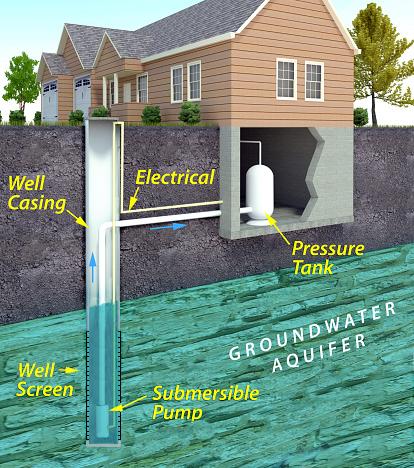About Private Water Wells
On this page:
Basic information about private water wells
 Private water wells are typically shallow (less than 200 feet deep). They are often constructed with solid steel or heavy plastic well casings with screens to allow water to enter. They often contain below-grade water line connections to prevent freezing.Over 15 million U.S. households (approximately 15 percent of Americans) rely on private water wells for drinking water. Private water wells should be protected from contamination.
Private water wells are typically shallow (less than 200 feet deep). They are often constructed with solid steel or heavy plastic well casings with screens to allow water to enter. They often contain below-grade water line connections to prevent freezing.Over 15 million U.S. households (approximately 15 percent of Americans) rely on private water wells for drinking water. Private water wells should be protected from contamination.
If contaminated ground water is consumed, it could cause illness. Ground water contamination can come from many sources, including:
- Seepage through landfills
- Failed septic tanks
- Underground storage tanks
- Fertilizers and pesticides
- Runoff from urban areas
If your family gets drinking water from a private well, do you know if your water is safe to drink? What health risks could you and your family face? Where can you go for help or advice?
The information on this website will help you answer these questions.
EPA regulates public water systems. EPA does not, however, have the authority to regulate private drinking water wells. Private water supplies are not subject to EPA standards. Some state and local governments do set rules to protect users of these wells.
Unlike public drinking water systems, private wells do not have experts regularly checking the water’s source and its quality before it is sent to the tap. Households that use private wells must take special precautions to ensure the safety of their drinking water supplies.
Types of wells
There are three types of private drinking water wells.
- Dug wells are holes in the ground dug by shovel or backhoe and are typically lined (cased) with stones, brick, tile, or other material to prevent collapse. Because dug wells are typically shallow (approximately 10 to 30 feet deep) they have the highest contamination risk.
- Driven wells are hammered or hydraulically pushed into the ground and pull water from the water-saturated zone. Driven wells are also shallow (approximately 30 to 50 feet deep) and have a moderate-to-high risk of contamination from nearby land activities.
- Drilled wells are deeper (approximately 100 to 400 feet) and typically have metal or plastic pipe casing which protect the well water from sources of contamination. Drilled wells have a lower risk of contamination. However, no well can be assumed to be contamination-free.
Well construction
Proper well construction and continued maintenance are keys to the safety of your water supply. Your state water-well contractor licensing agency, local health department, or local water system professional can provide information on well construction.
The well should be located so rainwater flows away from it. Rainwater can pick up harmful bacteria and chemicals on the land’s surface. If this water pools near your well, it can seep into it and potentially cause health problems.
Water-well drillers and pump-well installers should be bonded and insured. Make certain your ground water contractor is registered or licensed in your state, if required, and preferably certified.
If your state does not have a licensing or registration program, visit the National Ground Water Association resources for private well ownersExit to find certified water well contractors near you. The National Ground Water Association has a voluntary certification program for contractors. Some states use the Association’s exams as their test for licensing.
Keeping your well safe
To keep your well safe, be aware if any possible sources of contamination are nearby. Check with your local health department or environmental program for setback requirements. Possible sources of contaimnation could include:
- Septic tanks
- Livestock yards, silos, septic leach fields
- Petroleum tanks, liquid-tight manure storage, and fertilizer storage and handling
- Manure stacks
The following are tips for keeping your well safe.
- Maintain your well, find problems early, and correct them to protect your well’s performance. Many homeowners tend to forget the value of good maintenance until problems reach crisis levels. This can be expensive.
- Keep up-to-date records of well installation and repairs, plus pumping and water tests. Such records can help you spot changes and possible problems with your water system. If you have problems, find a local expert to check your well construction and maintenance records.
- Protect your own well area. Be careful about storage and disposal of household and lawn care chemicals and wastes. Best-practice farmers and gardeners minimize the use of fertilizers and pesticides.
- Take steps to reduce erosion and prevent surface water runoff.
- Regularly check underground storage tanks that hold home heating oil, diesel, or gasoline.
- Make sure your well is protected from the wastes of livestock, pets, and wildlife.
